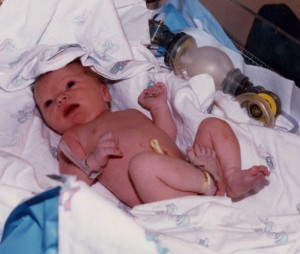“Cord-blood banking: worth it or not?” That’s the headline in an article in the Health Section of today’s Los Angeles Times. But I think a better question is: Cord-blood donation: why isn’t is easier?
It has been 10 years now since I donated by baby’s cord blood. I only knew about this option because a friend of mine had a son with leukemia. She had told me that an experimental treatment using donated umbilical cord blood had saved his life. Once I learned about the magical powers of the stem-cell-rich cord blood that is routinely discarded after a baby is born, I jumped at the chance to donate the blood from the umbilical cord I shared with my baby.
It took a little research to figure out how to donate. But I started researching early in my pregnancy. I filled out the proper paperwork and talked to my doctor. She had collected cord blood a couple times for private banking but was unaware that you even could donate.
After I gave birth, all it took was a few minutes for her to collect the blood, and the package was picked up by UPS I think. That was it. So simple.

But a couple years later when my son was born I could not find public umbilical cord bank willing to accept a donation. So this time, our precious fluid was simply discarded.
In the decade since I first donated, doctors have learned more about the healing power of umbilical cord blood. A growing for-profit industry sprung up. Private banking allows parents store their own cord blood in the off chance that their child will need it some day. I can understand parents who can afford it wanting to pay for private banking, especially when the public cord banks may not have an exact match of blood type. But only wealthy families can afford the hundreds of dollars in collection and storage fees. And the chances of any one baby needing the blood is small.
As a public policy issue, what we need is a cord blood bank system similar to the regular blood bank system.
As the Times article put it:
“The number of privately stored units of cord blood, estimated at 500,000 nationwide, far exceeds those in public banks even though cord blood in public banks is much more likely to be used. An estimated 300,000 units of donor cord blood are available worldwide.”
It just so happens that my friend had a neighbor who ended up running for an assembly seat in California. He had also been inspired to try to donate cord blood when his daughter was born and found it difficult. The first bill Assemblyman Anthony J. Portantino (D-La Cañada Flintridge) introduced after he was elected was to try to establish a network of hospitals in California to harvest umbilical cord blood. That hasn’t happened yet. But it should.
Collecting and storing cord blood is expensive. But since cord blood is rich in stem cells and holds promise of helping in difficult medical cases, I think we should be able to come up with a way to support better public banking.
I feel lucky that my daughter and I were able to donate our cord blood 10 years ago. I only wish my son and I could have done the same, and that all parents-to-be had this option easily available.
If you want more information on donating, visit the Parents Guide to Cord Blood. It lists which banks are accepting public donations and gives a great overview of how and why to donate.
If you have donated, or have a child who has benefited from cord-blood treatment, please share your experience below.
I really like this crib. And it is a great price!
If you do not already have a good digital camera, get one before your baby is born. You are going to use it.
Check out my post on making baby burp cloths.